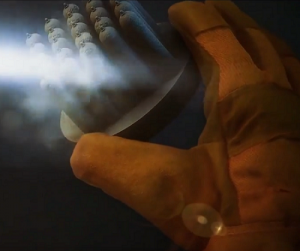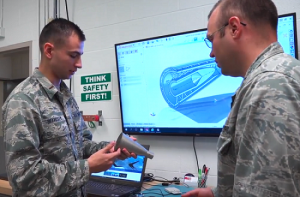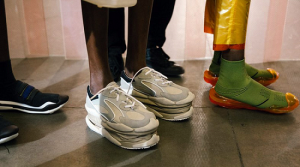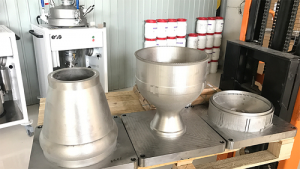We’ve got a little business for you today in the first edition of 3D Printing News Briefs this October, followed by some examples of the seemingly endless applications for 3D printing. Manufacturing equipment provider Metal Fish LLC has undergone rebranding with a new name and logo, and a European gas company suggests the use of its abrasive, CO2 snow particle-based material for metal 3D print surface cleaning. After acquiring a Concept Laser M2 Cusing metal 3D printing system last year, AFIT explains what it’s doing with metal 3D printing these days, and Skyrora is gearing up to test its 3D printed rocket engines. Moving from the defense and aerospace world to the fashion one, a Japanese designer has launched a high tech fashion label that includes 3D printed shoes, and Julia Daviy gives us a closer look at her 3D printed, sustainable Pure Nature suit.
Metal Fish LLC Rebranding
 Sometimes in life, it’s necessary to reinvent yourself a time or two. Will Shambley is a 3D printing pioneer who headed up materials R&D at Zcorp starting in 2000 and later cofounded Viridis3D. After that he founded in 2016 Metal Fish LLC a Massachusetts-based foundry technology consultancy. The company provides equipment for 3D printing, robotic solutions, consumables, foundry automation, and simulation software, among others, and was looking to clarify its mission, in addition to renewing its focus on the North American metal casting industry. So last month, Metal Fish was rebranded as New England Foundry Technologies.
Sometimes in life, it’s necessary to reinvent yourself a time or two. Will Shambley is a 3D printing pioneer who headed up materials R&D at Zcorp starting in 2000 and later cofounded Viridis3D. After that he founded in 2016 Metal Fish LLC a Massachusetts-based foundry technology consultancy. The company provides equipment for 3D printing, robotic solutions, consumables, foundry automation, and simulation software, among others, and was looking to clarify its mission, in addition to renewing its focus on the North American metal casting industry. So last month, Metal Fish was rebranded as New England Foundry Technologies.
“I’ve been poking around the North East US, explaining what “Metal Fish” was supposed to stand for since 2016,” explained Will Shambley, the company’s Owner and President. “And, while it was fun to say “fishing from foundry to foundry,” it didn’t necessarily reflect the focus and admiration that I have for this industry. (Also, nobody accidentally searches for Metal Fish, so google wasn’t helping me out.)
“So whether you met me at Z Corp, Viridis3D, as “The Metal Fish” or somewhere else, here’s the re-branding announcement, an updated logo, web page with new content, and lots of continued enthusiasm about new technologies to help make American foundries more competitive.”
Use AGA’s Cryonclean Snow for Metal 3D Printed Part Surface Cleaning
 Whether you’re using ultrasonic technology, DyeMansion’s Powershot C, or Yellow Magic 7, it’s often necessary to clean our 3D printed parts. Sweden-based AGA, northern Europe’s leading industrial gas company and part of The Linde Group, suggests the use of its CRYOCLEAN Snow+ material for surface cleaning of metal 3D printed parts. The unique material combines abrasives with CO2 snow particles, in order to remove surface oxidation and un-fused metal powders from completed 3D prints.
Whether you’re using ultrasonic technology, DyeMansion’s Powershot C, or Yellow Magic 7, it’s often necessary to clean our 3D printed parts. Sweden-based AGA, northern Europe’s leading industrial gas company and part of The Linde Group, suggests the use of its CRYOCLEAN Snow+ material for surface cleaning of metal 3D printed parts. The unique material combines abrasives with CO2 snow particles, in order to remove surface oxidation and un-fused metal powders from completed 3D prints.
The solution comes with a dedicated CO2 blasting cabinet, which propels the material under high pressure at the surface of 3D printed components. The jet then permeates cracks, and lifts any contaminants clean off the surface. Watch the video to learn more:
Metal 3D Printing at AFIT
 Last March, the Air Force Institute of Technology (AFIT) at Ohio’s Wright-Patterson Air Force Base made the decision to acquire a Concept Laser M2 Cusing metal 3D printer. The M2 was selected because it requires minimal handling of the metal powder when compared to other metal 3D printers, and AFIT said at the time that it would be used to advance the production and use of major aerospace metals aluminum, Inconel, and titanium. Now, AFIT has published a video with an update on what the institute has been up to with its metal 3D printing.
Last March, the Air Force Institute of Technology (AFIT) at Ohio’s Wright-Patterson Air Force Base made the decision to acquire a Concept Laser M2 Cusing metal 3D printer. The M2 was selected because it requires minimal handling of the metal powder when compared to other metal 3D printers, and AFIT said at the time that it would be used to advance the production and use of major aerospace metals aluminum, Inconel, and titanium. Now, AFIT has published a video with an update on what the institute has been up to with its metal 3D printing.
“We’ve produced bars for testing, vibrational testing,” said Captain Andrew Lingenfelter, an Assistant Professor at AFIT. “We’ve also produced complex lattice structures, energy absorption structures, and we’ve also done research into different types of penetrating type warheads printed with additive manufacturing.”
Students in AFIT’s Aircraft Survivability course also use the technology.
Skyrora to Test 3D Printed Rocket Engine
Edinburgh-based space company Skyrora is working to help cut down on the increasing backlog of un-launched small satellites. Recently, the manufacturer unveiled the three 3D printed engine parts for its own rocket engine, which it is preparing to test before the end of the year. The engine design offers 30kN of thrust at sea level, and will be used for the Skyrora One launcher. The engine’s chamber, injector head, and nozzle were all 3D printed out of the Inconel nickel alloy using powder bed technology. According to Skyrora’s lead engineer Robin Hague, 3D printing is a “perfect fit” for the company, as it allows for the creation of more complex structures.
Hague explained, “The ability to print the complex shape of the engine and also reduce the part count… means we can make our engine quickly and cost effectively.
“Engines typically have double walls, and one propellant is pumped through that double wall to keep the chamber cool. With additive manufacturing, you can make that wall in one piece – printing the double wall and printing the gap for the propellant in one go.”
Fashion Designer Making 3D Printed Shoes
 Japanese fashion designer Mikio Sakabe likes to use smart materials and 3D printing in his work. A few years ago, inspired by his residency in Tokyo – a fairly technologically advanced city – Sakabe decided to launch his Giddy Up fashion tech label. The latest collection from the label, which was showcased in Paris recently, is made up of a variety of 3D printed shoes. The avant-garde, 3D printed footwear in this collection is marching us ever onward to the future of fashion…which is apparently very colorful and high off the ground on teetering soles. The high-tech, 3D printed collection was inspired by Sakabe’s “vision of a new human” living in the future.
Japanese fashion designer Mikio Sakabe likes to use smart materials and 3D printing in his work. A few years ago, inspired by his residency in Tokyo – a fairly technologically advanced city – Sakabe decided to launch his Giddy Up fashion tech label. The latest collection from the label, which was showcased in Paris recently, is made up of a variety of 3D printed shoes. The avant-garde, 3D printed footwear in this collection is marching us ever onward to the future of fashion…which is apparently very colorful and high off the ground on teetering soles. The high-tech, 3D printed collection was inspired by Sakabe’s “vision of a new human” living in the future.
Sakabe said, “To create new, the industry should come up with fresh ideas and innovative materials, not just designs.”
Julia Daviy’s 3D Printed Pure Nature Suit
Ecologist, clean technology industry manager, and fashion designer Julia Daviy is creating a new kind of biodegradable fashion out of 3D printed plastic. She believes that 3D printing may replace traditional textiles someday, and that the technology can be used to solve worldwide problems like animal exploitation.
Not long ago, Daviy released the first 3D printed fashion collection in the US that consists of clothing made with large-format 3D printing, as well as pieces that are considered to be functional and wearable. Last week, she published a video to her YouTube channel giving us a closer look at the Pure Nature Suit, one of the sustainable, 3D printed pieces in her recent collection. The top and skirt, made with the popular Voronoi pattern, are both super flexible since the lining was made out of eco-friendly fabric from recycled fishing nets.
Take a closer look at the white and neon green 3D printed Pure Nature Suit in the video below:
Discuss these stories and other 3D printing topics at 3DPrintBoard.com or share your thoughts in the Facebook comments below.
Subscribe to Our Email Newsletter
Stay up-to-date on all the latest news from the 3D printing industry and receive information and offers from third party vendors.
You May Also Like
Further Understanding of 3D Printing Design at ADDITIV Design World
ADDITIV is back once again! This time, the virtual platform for additive manufacturing will be holding the first-ever edition of ADDITIV Design World on May 23rd from 9:00 AM –...
3D Printer Maker EVO-tech Reborn as NEVO3D — Once More With Feeling
EVO-tech was a 3D printing service and original equipment manufacturer established in 2013 and based in Schörfling am Attersee, Austria. The company produced high-quality material extrusion systems featuring linear bearings,...
3D Systems Brings 3D Printed PEEK Cranial Implant to the U.S. with FDA Clearance
For more than 10 years, 3D Systems (NYSE:DDD) has worked hand-in-hand with surgeons to plan over 150,000 patient-specific cases, and develop more than two million instruments and implants from its...
CDFAM Returns to Berlin for Second Annual Symposium
The second CDFAM Computational Design Symposium is scheduled for May 7-8, 2024, in Berlin, and will convene leading experts in computational design across all scales. Building upon the first event...

































